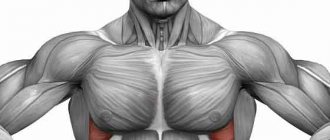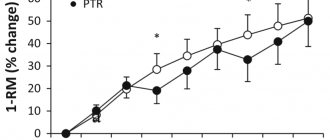Why train 2 times a day?
Many experienced bodybuilders use a 5-day training program, which can look like this:
- Monday - chest.
- Tuesday - legs.
- Wednesday - shoulder girdle.
- Thursday - back.
- Friday - hands.
This training program has one very significant drawback - the body is given little time to recover.
Although at a quick glance it may seem that the muscles manage to rest for about 48 hours, in practice this does not happen. If you visit the gym every day, then, for example, during back training, the arm muscles also have a certain load. It is quite obvious that this cannot be allowed. It is also necessary to remember that the nervous system actively works during any physical activity, regardless of which muscle group is being worked. Even if we assume that the muscles have enough rest during a five-day training program, this definitely cannot be said about the central nervous system.
Let us remember that it is the nervous system that needs the most time to recover after training. Working constantly every day in training, the fatigue of the nervous system accumulates and one day it will begin to malfunction. As a result, serious health problems may arise. You are already beginning to understand what answer Jeff Bauer will give to the question of whether it is possible to train 2 times a day.
Let's look at his arguments, because you shouldn't immediately start using something without receiving enough evidence of its effectiveness. The first thing you should pay attention to is saving time. By holding two classes a day, other days of the week are freed up.
It is necessary to forget that frequent training allows you to achieve your goal faster. This myth has been hovering over athletes for a long time and it’s time to dispel it. If you load your muscles until they have fully recovered and grown, then you are only harming your body. As a result, instead of growing muscles and physical parameters, this approach to organizing the training process will bring exactly the opposite results.
However, with a little training, troubles can be avoided. Such training does not cause a powerful destructive blow to muscle tissue, since you have provided the body with sufficient time to recover. He will be able to prepare for new powerful loads. By training twice a day, you can give yourself one extra day off.
Using a 5-day training program over the course of a year, a natural athlete can gain about two kilos of mass. If you switch to training twice a day, then in a year your muscle mass gain can be up to five kilos. Agree, for this reason alone it is worth thinking not about whether it is possible to train 2 times a day, but how to do it faster?
You can often hear from athletes that after a long period of active regular training they were unable to achieve their goal. Many people think that they simply haven't trained enough. However, most often the reason is overload of the muscles, which in such a situation will not grow. If you divide one lesson into two parts, the results will almost double.
How to properly train 2 times a day?
- Time.
If you decide to start training twice a day, then first of all you need to create the right routine. The first lesson should be held in the morning, and the second in the afternoon or evening. At the same time, in each training session you need to give your all. It is very important to remember that there must be a sufficient break between classes on the same day to allow the body to regain strength. Let's say, a two or three hour break is clearly not enough for this. - Rest.
You must always remember that muscles do not grow during the activity itself, but only during rest. If your job involves serious physical activity, then most likely this training regimen is not suitable for you. Fitness experts consider six hours to be the optimal interval. - Nutrition.
No matter how much you train, you need to devote enough time to nutrition. After class, you need not just to eat, but to be satiated. The diet must include foods containing protein compounds and carbohydrates. It is very important to ensure that you do not feel hungry before starting the second lesson. Note that it is necessary to limit fat intake so as not to slow down the delivery of other nutrients to target tissues. In addition, on training days it is necessary to increase the energy level of the diet, since energy consumption will be enormous. - Balance.
Every athlete should try to avoid overtraining. From this we can conclude that it is necessary to find a balance between activities with high and low intensity. It is important to gradually increase the frequency of training, duration and intensity. We recommend that most athletes avoid two high-intensity sessions per day. - Duration of the lesson.
Since it is recommended to train for an hour or a maximum of one and a half hours throughout the day, when doing two classes a day, do not spend more than 30–45 minutes in the gym at a time. You should listen carefully to your body so as not to end up in a state of overtraining.
Once you know the most important factors, all you have to do is create your own lesson plan. Most often, athletes train their legs in the morning, since this requires a lot of energy. If you are not sure that your existing potential is enough for this, then you can work on your upper body first, and train your lower body in the evening. Here is an example of a training program that can serve as a guide for you:
- Monday - lower and upper body in the morning and evening, respectively.
- Tuesday, Thursday, Saturday and Sunday are closed.
- Wednesday – Work on the top in the morning and work on the bottom in the evening.
- Friday - we train the lower body in the morning, and work on the upper body in the evening.
Commenting on the presented training program, it should be said that on the second and fourth days of the week you need not to stress the heart and vascular system.
If for some reason this fails, then on Saturday and Sunday you should only rest. An important issue is the choice of power movements. Focus on basic exercises such as squats, deadlifts, pull-ups, etc. At the same time, it makes no sense to refuse exercises to work the biceps, calves and muscles of the shoulder girdle. Each movement should perform about 25 repetitions. However, if the exercise involves several muscle groups at once, then 20 repetitions will be enough.
Training program according to option 1[edit | edit code]
Monday, back[edit | edit code]
- Horizontal block row or bent over row 3x8-10
- T-bar row 3x8-10
- Vertical block rows to the chest or pull-ups to the chest with a wide grip 3x8-10
- Vertical pull-down to the chest with a reverse narrow grip 3x8-10
- Shrugs with a barbell 3X8-10
- Hyperextensions 3x8-10
Brief explanations for back training[edit | edit code]
The first two exercises are designed primarily to work on the thickness of the back. The second two exercises form a cone, the width of the back. The fifth exercise, shrugs, is designed to develop the trapezius muscles. Some athletes perform shrugs on the day of deltoid training, which is also quite acceptable.
Tuesday, chest[edit | edit code]
- Bench presses on a horizontal bench 3-4x8-10
- Incline Dumbbell Presses 3-4x8-10
- Dips 3-4x8-10
- Crossovers on upper blocks 3x12-15
Brief explanations of chest training[edit | edit code]
The first three exercises are basic and are designed to work different sectors of the pectoral muscles - middle, upper and lower, respectively. Crossovers are an isolated exercise designed for the final finishing of the pectorals and their maximum blood supply. Let me remind you that this program is indicative. The exercises in it can be replaced with others similar to those presented. Fortunately, their choice in a bodybuilder’s arsenal is very large.
Wednesday, legs[edit | edit code]
- Squats with a barbell on the shoulders 3-4x8-10
- Platform leg press 3-4x8-10
- Leg extensions in the machine while sitting 3x10-12
- Bend legs in the machine lying face down 3-4x8-10
- Deadlift on straight legs 3-4x8-10
- Calf raises in a calf machine while standing or sitting 3x12-15
Brief explanations of leg training[edit | edit code]
The first three exercises are designed to develop the quadriceps of the thighs, with the first two being basic. The fourth and fifth exercises develop the hamstrings. The last exercise is designed to develop the muscles of the lower leg. Moreover, the position of the body is of fundamental importance; calf raises are performed while sitting or standing. In the first case, the soleus muscle is predominantly worked, in the second - the gastrocnemius. Ideally, you should perform both variations of calf raises within the same workout. However, this will lengthen and complicate an already difficult workout, so at first you can alternate them with each other from training to training. Or, as an option, spread them over other training days. For example, standing calf raises are for chest training, and sitting calf raises are for deltoid training.
Thursday, deltoids[edit | edit code]
- Dumbbell press up while sitting on a bench 3x8-10
- Press from the chest (from behind the head) while sitting in a Smith machine 3x8-10
- Dumbbell swings from the sides up while standing 3x10-12
- Dumbbell swings while standing at an incline 3x10-12
Brief explanations of deltoid training[edit | edit code]
The first two exercises are basic for the deltoids, putting stress on all heads. The third exercise works in isolation on the middle head of the deltoids, and the fourth - on the back. There is no direct load on the front head yet, because it already receives enough during all kinds of bench presses, sitting and standing.
Friday, hands[edit | edit code]
- French press 3-4x8-10
- Triceps extensions on the upper block 3-4x10-12
- Single arm extensions with dumbbell 3-4x10-12 each hand
- Standing biceps curl 3-4x8-10
- Hammers standing 3-4x8-10
- Scott's bench 3-4x10-12
Brief explanations of the program[edit | edit code]
This program is average and designed for those who have resorted to a five-day split for the first time in terms of gaining weight. The exercises in this program can be replaced with others similar to them. In addition, focusing on the development of lagging muscle groups, it will be necessary to add a few exercises somewhere or, conversely, subtract them. The program is not a dogma, but only a basis for various variations.
Advantages and disadvantages of training 2 times a day
We have already answered the question whether it is possible to train 2 times a day. Let's take a closer look at all the pros and cons of this approach to organizing classes. Please note that this training system is not suitable for every athlete. If you have just started doing fitness, then such loads may be excessive. In addition, many find it difficult to find free time to organize a second training session. But the system has certain advantages.
pros
- After doing the warm-up before your second workout, you may get a second wind. The human body adapts perfectly to new living conditions and in a short time will get used to the new training regime.
- Endurance increases - now we are talking not only and not so much about physical endurance, but psychological. Agree that for fitness enthusiasts it is extremely difficult to get in the mood for two workouts in one day.
- A complex activity is divided into two simpler ones - it is not necessary to conduct two strength training sessions on the same day. For example, you can schedule a cardio session for the morning. And in the evening, work with weights.
- Experienced athletes can perform only basic movements in the first lesson, and devote the second to isolated movements.
- We have already mentioned the increase in the number of days off, but let us note this advantage again.
- If desired, you can combine two types of fitness.
- Properly organized two-time classes will allow you to achieve your goal faster.
Minuses
Any business can have its downsides, and 2-time workouts are no exception:
- The risk of overtraining increases
- if you have been involved in sports for less than two years, then you should think carefully about the advisability of switching to this training system. The line between sufficient and excessive load is thin and you may not stay on it. - The system is not always effective for losing weight
- in order to get rid of excess weight, you need to reduce the caloric content of your diet. If you train twice a day, you will need a lot of energy, which cannot be delivered to the body due to caloric restriction. It should be remembered that your body is already in a depleted state. - You need to find time for two workouts
- not every person will be able to adjust their daily routine to such a training regime. Household problems and affairs can make adjustments, and you will have to skip training. If classes are not regular and you often have to skip them, then this will only slow down your progress.
Let us remind you that this system is suitable for all athletes and you should conduct an experiment, tracking the results.
Often, for a bodybuilder, and especially an amateur, it is enough to train three or four times a week. Scientists believe that it takes up to six days to restore a muscle group. The supercompensation phase, in turn, occurs only on the sixth or seventh day. When and how to start training 2 times a day, learn from this video:
When you are busy, or the gym is located far from home, going to the gym 3-5 times a week is inconvenient. A training program for 2 days a week comes to the rescue.
Program 2[edit | edit code]
Based on the exercises given above, or adding them a little, you can vary the split systems. For example, add deltoids or arms to the training of legs, respectively, removing them from the first training to the top. Then the split might look like this:
First training[edit | edit code]
- Incline bench press 3x8-10
- Dumbbell fly on a horizontal bench 3x8-10
- Upper pulley to chest 3x8-10
- Bent-over barbell row 3x8-10
- Standing biceps curl 2x10-12
- Dips with weights 2x10-12
Second training[edit | edit code]
- Squats with a barbell on the shoulders 3x8-10
- Platform leg press 3x8-10
- Leg curls in the machine 3x8-10
- Standing calf raises in the machine 2x12-15
- Seated vertical chest press in Smith machine 3x8-10
- Dumbbell swings from the sides up while standing 3x10-12
- Dumbbell swings while standing at an incline 3x10-12
What can you achieve by exercising twice a week?
Become slimmer
A two-day training program will help solve the issue of losing weight. If you follow the correct diet, this training schedule is acceptable.
We would like to warn you that this frequency of training is not the best for losing body fat; the process of losing weight will be slow. But you can exercise for pleasure, because double training will not take much time.
Gain weight
Mass training can also be done twice a week. This is a very convenient option for those whose muscles take a long time to recover.
Typically, 36–48 hours of rest is not enough for such athletes; they need up to three days between classes. This is where 2 workouts a week helps out.
For strength exercises, this is the best option - you can rest for a long time and restore your muscles.
Keep fit
Working out in the gym 2 times a week will help keep your body in shape. This is the optimal schedule to achieve this goal.
Little time is spent, excess fat accumulates slowly or is not deposited at all (depending on proper nutrition).
Example of a two-day split
Let me give you an example of a classic weekly split scheme, which allows you to work almost all the muscles of the body in two sessions. Remember that this is one option for constructing a training plan. It can be used as an initial template, supplemented with other exercises, or simply used in any microcycle.
At home
An example of a “top-bottom” plan for home for two classes per week.
Workout #1
- Push-ups – 4*10-12.
- Pull-ups – 4*8-10.
- Dumbbell press standing or sitting – 4*10.
- One-arm dumbbell row – 3*10.
- Pullover with dumbbell – 3*8.
- Standing dumbbell curl for biceps – 3*10.
- Bending your arm back – 3*10.
Workout #2
- Front squats with dumbbells – 4*10.
- Deadlift with dumbbells – 4*10.
- Lunges/reverse lunges with dumbbells – 4*12 (per leg).
- Explosive jumps from deep squat – 3*12.
- Calf raise with dumbbells – 3* to failure.
In the gym
An example of a classic split for the gym for 2 workouts per week.
First day (chest/back/arms):
- Bench press – 3*8-10.
- Lying dumbbell flyes – 3*10.
- Horizontal thrust – 3*8-10.
- Bent-over barbell/dumbbell row – 3*10.
- Standing barbell/dumbbell curls for biceps – 3*10.
- Close grip bench press/parallels -3*10.
Day two (legs/calves/shoulders):
- Squats with a barbell – 3*8-10.
- Leg press – 3*10.
- Superset of leg bending and extension in the simulator – 3*10.
- Calf raise – 3*20-25.
- Seated shoulder press in Smith – 3*8-10.
- Swings with dumbbells to the sides - 3*10.
- Bent over dumbbell ointments – 3*10.
Why you shouldn't exercise less often
Let's be honest. Once a week you can go skiing, walk in the park, swim in the pool, visit the bathhouse and sauna. You can do anything one-time that does not require constant maintenance and consolidation of results.
If you want to learn how to swim quickly, you need to practice more often. A lesson once a week is suitable only for relaxation and recovery. But training is not done in this mode.
Therefore, in order to achieve any of the three above goals, you need a training program 2 times a week.
To maintain muscle tone, they need to be worked out at intervals of 24–72 hours. Once a week you can only do very heavy loads, for example, deadlifts with a failure weight. But this does not mean that you cannot train your lower back and legs more during the week after deadlifting. Just the opposite - it is necessary, but with different exercises.
Keep in mind that heavy training for a particular muscle group should be done once a week. Exceptions are cases when the athlete’s muscles quickly recover and adapt to the load.
However, it is undesirable to combine deadlifts and squats on the same day, if we are talking about a two-day training.
Three principles for building a two-day split
The program is based on compliance with the following three areas:
- muscle mass should be divided exactly into two parts, which allows you to use 50% of the body on each training day;
- the back extensors and spine should receive extremely uniform loads;
- The shoulder joint moves over a large amplitude and is most susceptible to various types of injuries, which also imposes a requirement for the distribution of the applied load, which should be the same on each day.
The maximum load on the spinal column comes from deadlifts and squats. This is the reason why the back and lower extremities should be worked on different days. Experienced bodybuilders know about this feature and never train both of these muscle groups on the same day.
Following the third principle, also work out the deltoids and chest separately. There are no restrictions for the abdominal cavity. It is permissible to pump the press at any time. Recovery is achieved by taking a day break between workouts.
Training programs
Each goal will make its own adjustments to the program. Two workouts per week should be intensive to cover all muscle groups. At the same time, you need to try to think through the training schedule so as not to increase the duration of a one-time visit to the gym.
The preparation of the program should be carried out by an experienced athlete who is familiar with anatomy and physiology, as well as a perfect understanding of the technique of performing most exercises.
Let us remind you that for training twice a week, the program should be optimally capacious. We will show you with specific examples how to use this feature of a two-day training.
Weight loss program
A set of exercises for losing weight will look like this:
Day 1
- Cardio - 15-20 minutes at an average pace, at the end (last 3-4 minutes) perform one interval (maximum acceleration for 20-30 seconds). Then restore the rhythm and breathing for 2-3 minutes, only then stop completely.
- Leg press in the simulator - 3 sets of 15 times with light weight. You should feel the heaviness, but also have a reserve of strength for 15 or more repetitions. We do it quickly.
- Hyperextension - 2 sets of 20 times.
- Lunges with dumbbells - 3 sets of 15 times (should be hard, but with a reserve of strength).
- on a horizontal bench - 3 x 15 times.
- Bending arms with dumbbells while standing with supination - 2 x 15 times.
- Seated dumbbell press - 2 x 20 reps with light weight.
- Circuit training for the abs: 10 crunches on the mat; 10 hanging leg raises; 10 crunches on a Turkish chair; 10 leg raises from a lying position. On the last lift in the last exercise, we freeze in the “legs above the floor” position and hold it for 30 seconds. Rest for 60 seconds and repeat the abdominal circuit. We do 2-3 circles.
Between sets of other exercises you need to rest no more than 60 seconds, keep an eye on the time. Finish the workout with a small stretch of the large muscles (lower back, legs).
Day 2
- Cardio - 20 minutes at an average pace, at the end speeding up for 2-3 minutes, but not to the maximum. Accelerate to 13–16 km/h and maintain this speed for 2–3 minutes.
- in the simulator - 2 sets of 15 times, do the third approach until the muscles burn. When this feeling comes, do another 10 repetitions.
- Romanian or deadlift - 3 sets of 15 reps with a barbell or dumbbells.
- Plie squats (for girls) or leg press (for men) - 2 x 20 times.
- Hammer chest press or dumbbell bench press - 3 sets of 15 reps.
- Crossover in a block exercise machine on the lower chest.
- Extension of the arms on a block in a superset with curling the arms with a barbell or dumbbells (small weights) - 3 sets of each exercise in 15 repetitions.
- The final cardio workout is 10-15 minutes at a slow pace. Your task is to sweat, stretch tense muscles and prepare your body for a shower.
Limit yourself in calories, don't eat at night, less carbohydrates, more protein.
Mass gain program
A training program for gaining muscle mass is more suitable for men. Women without exogenous testosterone will have difficulty gaining muscle:
Day 1
- Cardio - 5-7 minutes. The task is to bring the heart to 140 beats per minute, gradually reduce the rhythm to 90-100 beats per minute.
- Hyperextension - 2 to 15.
- Leg press or deadlift (the first week we do the press, the second week we do the deadlift).
- Bench press - 5 sets of 5-6 reps each. Weights - refusal.
- Hammer press or 30 degree angle press (alternate every week).
- Seated barbell press or hammer shoulder work.
- Barbell curls for biceps - 3 to 8.
- Raising legs from dumbbells while hanging onto the abs (legs bent at the knees) - 3 sets of 8-10 reps until failure.
- Stretching on the mat.
Day 2
- Cardio - 5-7 minutes according to the plan for the first day.
- Squats with a barbell - 5 5-6 times.
- Leg press - 3 x 8-10 times.
- Bench press - 5 5-6 times.
- Extension of arms in a block simulator like a ladder - 12 times, 10, 8, 6, 4 (maximum weights).
- Rows of the upper block to the chest with a narrow grip - 3 8-10 times.
- T-bar row - 3 sets of 6-8 reps.
- Hammer curls with dumbbells while standing – 3 x 10 times.
A training program for gaining muscle mass should be optimized in such a way that you give your best. It is necessary that all your muscle groups receive a failure load.
A load after which you are no longer able to lift the working weight even once during training is considered a failure. This weight is not easy to determine. Personal experience and your own feelings will help you.
For example, if you did 8 repetitions in the first approach, and in the second you already threw the barbell at 5 or 6, the weight is too much for you. On the contrary, if after 8 repetitions you feel that you will do 2-3 more repetitions, the weight is light. Through trial and error you will find the best option for yourself.
Fitness program
You don't have to go to the gym for a great purpose. You can simply keep yourself in good shape:
Day 1
- Barbell squats - 3 sets of 10 reps with a comfortable weight.
- Hyperextension - 3 x 15 times.
- Leg bending and extension in a superset machine - 2 sets of 10 repetitions for each exercise.
- Pull-ups - 3 N times, where N is as many times as you can perform using pure technique.
- Bending and extension of arms with dumbbells in a superset - 2 sets of 10 repetitions for each.
- Hanging leg raises - 3 x 12 times.
- Stretching.
Day 2
- Cardio - 10 minutes at a moderate pace.
- Bench press - 3 x 10 times.
- Raising arms with dumbbells at an angle of 30 degrees - 3 x 10 times.
- Leg press - 3 x 10 reps with heavy weight.
- Bent-over barbell row to the lower back.
- Hyperextension - 3 to 15.
- Roman chair crunches – 3 x 12–15 times.
- Stretching.
2-Day Mass Split - Training Program
First day
- Back. The workout begins with a warm-up, and they try to do all the exercises presented below in half an hour, taking into account a thirty-second break between approaches:
- pull-ups;
- tightness of the upper block;
- bent over row;
- pull to the waist of the lower block.
All exercises are done in 3 sets, but barbell rows are supplemented with a warm-up approach, doing 8-12 repetitions in each, and squats until failure occurs.
- Shoulder girdle. Assumes a fifteen-minute execution alternating:
- military press;
- Wide grip chin pulls.
The load in both cases is 3x8-12.
- Triceps. Similarly, working out the shoulders takes a quarter of an hour and consists of two exercises:
- close grip presses;
- French press.
Do 3 sets of 8-12 repetitions.
What else to do
Crossfit
CrossFit can be practiced twice a week - this is the optimal regime. On the first day of training, for example, you hit your legs and shoulders. And in the second - arms, back and chest.
Let us remind you that in CrossFit the training is circular, and the intensity is more suitable for burning fat. In addition, there are many contraindications for this type of fitness.
Run
To improve your running performance, it makes sense to practice this amount of running. You can jog for 30–40 minutes, alternating intense short-term running with jogging (in other words, interval running).
Find out how best to train in the gym, on the horizontal bar: every day or two days in a row. Here you will find comments from experts about whether girls can go to the gym every day.
Answer:
In gyms, many people work out two to three times a week. But it often turns out that there are only two free days, and they come one after another. Is it possible to train every day in the gym? Practice has shown more than once that the best results come from those who exercise for several days in a row without breaks. But it is worth saying that even a trained person should not exercise every day, it is harmful. Unless you need to hang on the horizontal bar regularly. But it’s also worth taking breaks when doing difficult exercises.
In the case of training for two days in a row, the principle of alternating load becomes especially relevant. Including girls. Back in ancient Greece, people realized how beneficial it was to use different muscle groups. This principle is still often used if you can study for two days in a row.
Most professional athletes even devote time and attention to training several times a day. To lose weight, for example, such serious loads are not needed. Is it possible to train two days in a row, we answered. You shouldn’t take long breaks between classes at all, especially if you want to develop a specific muscle group.
Exercises can be made more difficult as a person gets used to the load.
5x5 training program for mass
An approximate class schedule for 5 days a week is as follows:
- Day 1 – Complex A
- Day 2 – Complex B
- Day 3 – Complex C
- Day 4 – Complex D
- Day 5 – Complex E
- Day 6 – Rest
- Day 7 – Rest
The advantage of starting classes on Monday is that while everyone else is doing chest presses and fiddling with dumbbells, you can calmly do deadlifts at the other end of the gym.
I would also recommend adding 20-30 minute cardio sessions after workouts at least twice a week to stimulate muscle growth and recovery.
When working out in the gym five times a week to build muscle mass, you should eat a lot of healthy and balanced foods. Chicken, broccoli, sweet potatoes, potatoes, bacon, ground beef, plenty of vegetables and whey protein will give your body everything it needs to grow, be strong and agility. The restoration of muscle fibers depends on an optimal diet and proper sleep patterns. Believe me, going to the gym and carrying heavy iron is not the most difficult task.
Complex A
| Exercise | Approaches | Max. number of repetitions |
| Deadlift | 5 | 5 |
| Shrugs with dumbbells | 3 | 8 |
| Rowing | 3 | 12 |
| Bent over dumbbell swings | 3 | 12 |
| Plank * | 3 | — |
Complex B
| Exercise | Approaches | Max. number of repetitions |
| Army press | 5 | 5 |
| Arnold press | 3 | 8 |
| Raising dumbbells forward | 3 | 12 |
| Dumbbell lateral raises | 3 | 12 |
Complex C
| Exercise | Approaches | Max. number of repetitions |
| Bent-over barbell row | 5 | 5 |
| Pull-ups | 3 | 8 |
| Barbell curl | 3 | 12 |
| Straight arm vertical block row | 3 | 12 |
Complex D
| Exercise | Approaches | Max. number of repetitions |
| Bench press | 5 | 5 |
| Incline dumbbell press with head up | 3 | 8 |
| Close grip bench press | 3 | 12 |
| One-arm triceps extension | 3 | 12 |
Complex E
| Exercise | Approaches | Max. number of repetitions |
| Squat | 5 | 5 |
| Raising on your toes *** | 3 | 8 |
| Leg bending on the simulator | 3 | 12 |
| Leg extension on the simulator | 3 | 12 |
| Plank * | 3 | — |
* - For planks, the number of repetitions is calculated differently. Perform the plank in three sets of one repetition, recording the result of each of them. Next time, try standing in one approach longer than the total time of the previous three. Reduce your rest time to 60 seconds, and try to tighten your abs and core muscles as much as possible and avoid arching your back.
*** - There are many variations of calf raises: sitting, standing, standing on a calf machine, standing in a Smith machine. Choose the one that suits you best.
If you have the courage to decide on such a tough training, leave a comment below. And after 8 weeks, come back and share your successes.
Is it possible to exercise if your muscles are still sore from the last workout?
If pain occurs in the muscles, this means that they have not yet recovered from the previous load. If the pain is severe, then you can only give a negative answer to the question of whether it is possible to train if the muscles still hurt after the last workout. If the sensation is insignificant, then you can give it a load. The main thing is that it is also light.
This means that literally one or two exercises are given for each muscle, each with about two approaches. In this case, no more than 60 percent of the worker should be the weight of the shells. Repetitions are done no more than 10-12. But such classes should be carried out only if there is really a desire. Otherwise, you should wait until the pain subsides.
If you do not do too much strength exercises, they even help speed up the recovery process. Increased blood flow and nerve stimulation contribute greatly to this. You can compare such warm-ups with a restorative massage. Warming up and cooling down can be an excellent preventive measure for muscle pain. Thanks to this, the workout itself will become more comfortable, and the feeling after it will be more pleasant. Then the result will be of better quality.
You can train the same muscle group two days in a row. In fact, this is the best thing you can come up with for optimal growth, and here's why.
This double stimulation
increases protein synthesis in muscles, causes a “response” to stress, and also increases neuromuscular communication.
The second approach increases anabolic
reaction from the first. This occurs due to an increase in the period of protein synthesis, as well as due to the acceleration of the transport of nutrients to the muscles. But only on one condition.
Program Two-day split top and bottom
With this approach, in the first workout you work the upper body, in the second workout you work the lower body.
Workout 1 (top)
- (chest) Barbell press on a horizontal bench 3 x 8 – 10
- (chest) Dumbbell fly on an incline bench. 3 x 8 – 10
- (back) Bent-over barbell row 3 x 8 – 10
- (back) Pulldown of a vertical block to the chest 3 x 8 – 10
- (delta triceps) Seated barbell press up 3 x 8 – 10
- (biceps) Standing biceps curl 2 x 10 – 12
- (triceps) Vertical block triceps press down 2 x 10 – 12
The first workout involves training the upper part.
You can safely replace one or another exercise for one muscle group with another. For example, if you have scaleosis, then instead of bent-over barbell rows, you can do other exercises for the latissimus muscles, for example:
- Row of one dumbbell to the belt, standing in an incline position
- Upper cable pull on the block
- T-bar row
Workout 2 (bottom)
- Squats with a barbell 3 x 8 – 10
- Platform leg press (in the simulator) 3 x 8 – 10
- Deadlift 3 x 8 – 10
- Lying leg curls (in the simulator) 3 x 8 – 10
- Standing calf raises (in the simulator) 2 x 12 – 15
The second workout involves training the lower part.
What's the secret?
train the same muscle group in different ways
.
On the first day, you need to do a standard heavy workout
with your usual working weight. The next day, do a light warm-up for the same muscles in the first 15 minutes. Then, you can move on to the main training on another muscle group. Here is an example of using a double workout for 5 days, where you work out for 4 days and rest on the fifth.
Day 1:
Do a heavy workout on your chest and arms (For example, including a bench press in your program)
Day 2:
In the first 15 minutes of training, do exercises again on the muscles of the chest and arms, but this time light ones. A chain of several isolation exercises will work best. It is optimal to do 8-12 repetitions in each set. Each set of repetitions should last between 30 and 50 seconds. Then you can do your main heavy back workout.
Day 3:
Work on stretching the muscles you worked on the day before. Then train your legs.
Day 4:
Pump up your legs and abdominals.
Day 5:
Rest.
This tactic facilitates the recovery of the body and increases the duration of the anabolic phase.
. Protein synthesis remains elevated 24 hours after exercise. But by doing the second part of the workout the next day, which is less traumatic, you also significantly increase protein synthesis, so the muscle-building factory will work many times more intensely.
It is very important that the workout on the second day for the same muscles is light
, since it is important to prevent damage to the fibers, but to activate stimulating regeneration processes at the cellular level and the transport of nutrients to the muscles. In addition to training, it is important to focus on proper nutrition to achieve the best results.
When you are creating a training program, first of all, you need to decide on the first important point - the regularity of training.
. How many times a week should you exercise?
I understand... this is quite a broad question. And the terms “exercise regularity” and “exercise regularity” can have a lot of different meanings.
However, there are 3 values that are worth paying attention to:
- Regularity of training in general:
How often should you perform certain exercises (strength training, cardio, etc.)? - Strength Training Regularity:
How many times a week should you do strength training? - Regularity of exercises for specific muscle groups or body parts:
How many times a week should you train each muscle group or body part?
The only thing we missed on this list is cardio training. This is a separate topic that we will talk about a little later.
Now let's look at the 3 most important aspects of regular training.
Two-day training program
The two-day mass split is great for both beginners and more experienced athletes who are not using anabolic steroids. As you know, the growth of muscle mass without the use of steroids is possible only if the working weights in the exercises are constantly increased. However, most gym goers are in a deep state of stagnation. Due to the blind copying of champion training programs with which the entire Internet is littered, a natural’s body simply does not have time to recover, which leads to a state of overtraining in which there can be no talk of any progress. A two-day mass split allows for full recovery between workouts, which will have a positive effect on increasing the athlete’s working weights and muscle mass. With this training program, you are guaranteed to be able to break through plateaus and reach the next level. Tested by personal experience!
The most common options for constructing a two-day split are “TOP-BOTTOM” and “PULL-PUSH”. According to the first option, in the first workout you work the muscles of the upper body (CHEST, BACK, ARM), and in the second workout the muscles of the lower body (LEGS, PRESS). According to the second option, in one training session you work out pulling muscle groups (MUSCLES OF THE BACK AND BACK OF THE THIGH, BICEPS OF THE ARMS), and in another training session pushing muscle groups (CHEST MUSCLES, TRICEPS, FRONT DELTO, QUADRICEPS). For clarity, I will give examples of both options for a two-day weight split.
Regularity of training in general
The first thing to decide is how many times a week we will perform training. These may include strength training, cardio, and so on. All this relates to the regularity of classes in general.
This is one aspect that may vary depending on you and your goals (for example, an obese person with the initial goal of losing weight may do 4 cardio workouts per week, while a thin person with the initial goal of gaining muscle mass may not do cardio at all).
Therefore, it is impossible to say exactly how many times a week you need to exercise.
However, there is one general rule that works for everyone.
And this is the rule: take at least 1 day off from training.
.
This means that in the worst case scenario
You can exercise 6 times a week (and this includes strength training, cardio, etc.).
I am sure that among those reading this article there is no such person who needs to exercise 7 times a week and who will derive any benefits from it.
I will say more: most people will accept 3-5 times a week as the norm, depending on their goals.
Why? Because daily training not only makes no sense to achieve your goals, on the contrary, it can lead to the opposite results.
Program 1[edit | edit code]
Top-bottom muscle separation. In the first week, two upper and one lower workouts are performed. In the second - two bottoms and one top. Trainings are held on Mondays, Wednesdays and Fridays.
For example:
Monday is the first workout, Wednesday is the second, Friday is the first, Monday is the second.
First training. Top[edit | edit code]
The main muscle groups of the upper body are the back, chest, deltoids and arms. For each of them, at least one basic exercise must be performed. Based on this, the training is built.
- Bench press on a horizontal bench 3x8-10
- Fly (or press) on an incline bench. 3x8-10
- Upper pulley to chest 3x8-10
- Bent-over barbell row (or seated chest row) 3x8-10
- Seated barbell press in Smith machine 3x8-10
- Standing biceps curl 2x10-12
- Vertical block downward triceps press 2x10-12
Second training session. Bottom[edit | edit code]
- Squats with a barbell on the shoulders 3x8-10
- Platform leg press 3x8-10
- Deadlift 3x8-10
- Deadlift on straight legs 3x8-10
- Lying leg curls in a special machine 3x8-10
- Standing calf raises in the machine 2x12-15
Regularity of strength training
There are many individual characteristics that should be taken into account in the regularity of training in general. However, when it comes to strength training, the opposite is true. I can accurately describe the regularity of strength training.
The regularity of strength training refers to how many times a week you need to do it.
Some people can do 5 workouts a week (although in most cases they are not necessary at all), some people can stop at two. However, for most people, 3-4 strength training sessions per week is sufficient
.
I base this on most well-designed training programs that are 3-4 workouts per week.
The same applies to the rule not to perform more than 2 workouts in a row.
.
What is a two-day split?
The split training principle means that we train different muscle groups on different days, rather than the whole body each workout. Therefore, we only have two days to work out all the muscles. It is most rational to conditionally divide our body into top and bottom .
Training principle
In one day, we completely work out all the upper muscles - chest, back, arms, shoulders and abs, doing 2-3 exercises for large muscle groups and one for small ones. This amount of work will be quite enough to keep them in good shape and provide the prerequisites for growth. After two or three days of complete rest after training the upper body, we do a full volume training on the legs, at one time trying to properly load the quadriceps, hamstrings, gluteal and calf muscles.
This way you will have more than enough time to fully recover between workouts. After all, the larger the muscle, the more time it needs to recover. Therefore, it is advisable to make your workouts difficult, giving your full effort in every set of every exercise. This way you will consistently get bigger and stronger when using a two-day split. If you train carelessly, you will not achieve much results - two training sessions a week will not be enough due to the small amount of work.
Of course, there will be no growth even with insufficient nutrition. A calorie surplus of 10-20% of the daily requirement for a particular athlete is required.
Another option for a two-day split:
Recommendations for using the program
The program is suitable for those athletes who:
- There is no time or opportunity to visit the gym often.
- But at the same time there are enough resources (food, sleep) for recovery.
By training on the principle of a two-day split, we work several large muscle groups at once in one session. Therefore, it is worth using mainly only heavy basic exercises, after which you need a long recovery (we have a week for this), and a minimum of isolation. Sometimes it makes sense to add some cardio at the end of your workout. How to competently combine all this for people with different body types, read in the following sections.











